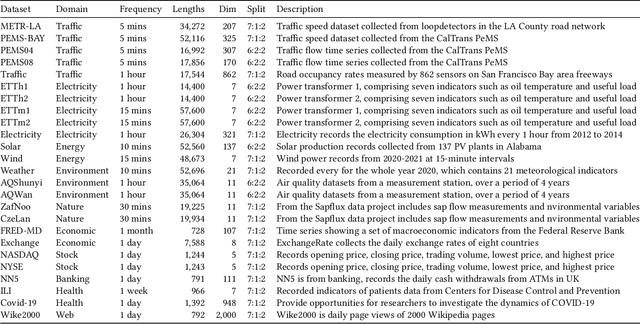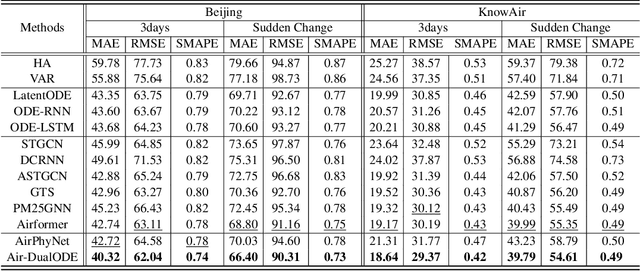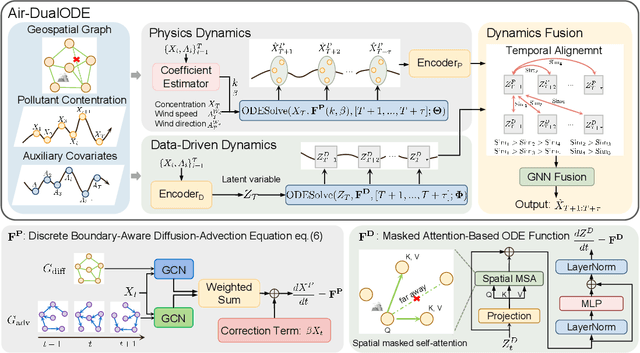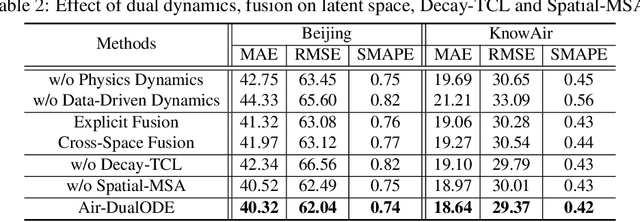Chenjuan Guo
AimTS: Augmented Series and Image Contrastive Learning for Time Series Classification
Apr 14, 2025Abstract:Time series classification (TSC) is an important task in time series analysis. Existing TSC methods mainly train on each single domain separately, suffering from a degradation in accuracy when the samples for training are insufficient in certain domains. The pre-training and fine-tuning paradigm provides a promising direction for solving this problem. However, time series from different domains are substantially divergent, which challenges the effective pre-training on multi-source data and the generalization ability of pre-trained models. To handle this issue, we introduce Augmented Series and Image Contrastive Learning for Time Series Classification (AimTS), a pre-training framework that learns generalizable representations from multi-source time series data. We propose a two-level prototype-based contrastive learning method to effectively utilize various augmentations in multi-source pre-training, which learns representations for TSC that can be generalized to different domains. In addition, considering augmentations within the single time series modality are insufficient to fully address classification problems with distribution shift, we introduce the image modality to supplement structural information and establish a series-image contrastive learning to improve the generalization of the learned representations for TSC tasks. Extensive experiments show that after multi-source pre-training, AimTS achieves good generalization performance, enabling efficient learning and even few-shot learning on various downstream TSC datasets.
Learning Generalizable Skills from Offline Multi-Task Data for Multi-Agent Cooperation
Mar 27, 2025Abstract:Learning cooperative multi-agent policy from offline multi-task data that can generalize to unseen tasks with varying numbers of agents and targets is an attractive problem in many scenarios. Although aggregating general behavior patterns among multiple tasks as skills to improve policy transfer is a promising approach, two primary challenges hinder the further advancement of skill learning in offline multi-task MARL. Firstly, extracting general cooperative behaviors from various action sequences as common skills lacks bringing cooperative temporal knowledge into them. Secondly, existing works only involve common skills and can not adaptively choose independent knowledge as task-specific skills in each task for fine-grained action execution. To tackle these challenges, we propose Hierarchical and Separate Skill Discovery (HiSSD), a novel approach for generalizable offline multi-task MARL through skill learning. HiSSD leverages a hierarchical framework that jointly learns common and task-specific skills. The common skills learn cooperative temporal knowledge and enable in-sample exploitation for offline multi-task MARL. The task-specific skills represent the priors of each task and achieve a task-guided fine-grained action execution. To verify the advancement of our method, we conduct experiments on multi-agent MuJoCo and SMAC benchmarks. After training the policy using HiSSD on offline multi-task data, the empirical results show that HiSSD assigns effective cooperative behaviors and obtains superior performance in unseen tasks.
Data Driven Decision Making with Time Series and Spatio-temporal Data
Mar 11, 2025Abstract:Time series data captures properties that change over time. Such data occurs widely, ranging from the scientific and medical domains to the industrial and environmental domains. When the properties in time series exhibit spatial variations, we often call the data spatio-temporal. As part of the continued digitalization of processes throughout society, increasingly large volumes of time series and spatio-temporal data are available. In this tutorial, we focus on data-driven decision making with such data, e.g., enabling greener and more efficient transportation based on traffic time series forecasting. The tutorial adopts the holistic paradigm of "data-governance-analytics-decision." We first introduce the data foundation of time series and spatio-temporal data, which is often heterogeneous. Next, we discuss data governance methods that aim to improve data quality. We then cover data analytics, focusing on five desired characteristics: automation, robustness, generality, explainability, and resource efficiency. We finally cover data-driven decision making strategies and briefly discuss promising research directions. We hope that the tutorial will serve as a primary resource for researchers and practitioners who are interested in value creation from time series and spatio-temporal data.
RCRank: Multimodal Ranking of Root Causes of Slow Queries in Cloud Database Systems
Mar 06, 2025



Abstract:With the continued migration of storage to cloud database systems,the impact of slow queries in such systems on services and user experience is increasing. Root-cause diagnosis plays an indispensable role in facilitating slow-query detection and revision. This paper proposes a method capable of both identifying possible root cause types for slow queries and ranking these according to their potential for accelerating slow queries. This enables prioritizing root causes with the highest impact, in turn improving slow-query revision effectiveness. To enable more accurate and detailed diagnoses, we propose the multimodal Ranking for the Root Causes of slow queries (RCRank) framework, which formulates root cause analysis as a multimodal machine learning problem and leverages multimodal information from query statements, execution plans, execution logs, and key performance indicators. To obtain expressive embeddings from its heterogeneous multimodal input, RCRank integrates self-supervised pre-training that enhances cross-modal alignment and task relevance. Next, the framework integrates root-cause-adaptive cross Transformers that enable adaptive fusion of multimodal features with varying characteristics. Finally, the framework offers a unified model that features an impact-aware training objective for identifying and ranking root causes. We report on experiments on real and synthetic datasets, finding that RCRank is capable of consistently outperforming the state-of-the-art methods at root cause identification and ranking according to a range of metrics.
Assessing Pre-trained Models for Transfer Learning through Distribution of Spectral Components
Dec 26, 2024Abstract:Pre-trained model assessment for transfer learning aims to identify the optimal candidate for the downstream tasks from a model hub, without the need of time-consuming fine-tuning. Existing advanced works mainly focus on analyzing the intrinsic characteristics of the entire features extracted by each pre-trained model or how well such features fit the target labels. This paper proposes a novel perspective for pre-trained model assessment through the Distribution of Spectral Components (DISCO). Through singular value decomposition of features extracted from pre-trained models, we investigate different spectral components and observe that they possess distinct transferability, contributing diversely to the fine-tuning performance. Inspired by this, we propose an assessment method based on the distribution of spectral components which measures the proportions of their corresponding singular values. Pre-trained models with features concentrating on more transferable components are regarded as better choices for transfer learning. We further leverage the labels of downstream data to better estimate the transferability of each spectral component and derive the final assessment criterion. Our proposed method is flexible and can be applied to both classification and regression tasks. We conducted comprehensive experiments across three benchmarks and two tasks including image classification and object detection, demonstrating that our method achieves state-of-the-art performance in choosing proper pre-trained models from the model hub for transfer learning.
EasyTime: Time Series Forecasting Made Easy
Dec 23, 2024



Abstract:Time series forecasting has important applications across diverse domains. EasyTime, the system we demonstrate, facilitates easy use of time-series forecasting methods by researchers and practitioners alike. First, EasyTime enables one-click evaluation, enabling researchers to evaluate new forecasting methods using the suite of diverse time series datasets collected in the preexisting time series forecasting benchmark (TFB). This is achieved by leveraging TFB's flexible and consistent evaluation pipeline. Second, when practitioners must perform forecasting on a new dataset, a nontrivial first step is often to find an appropriate forecasting method. EasyTime provides an Automated Ensemble module that combines the promising forecasting methods to yield superior forecasting accuracy compared to individual methods. Third, EasyTime offers a natural language Q&A module leveraging large language models. Given a question like "Which method is best for long term forecasting on time series with strong seasonality?", EasyTime converts the question into SQL queries on the database of results obtained by TFB and then returns an answer in natural language and charts. By demonstrating EasyTime, we intend to show how it is possible to simplify the use of time series forecasting and to offer better support for the development of new generations of time series forecasting methods.
DUET: Dual Clustering Enhanced Multivariate Time Series Forecasting
Dec 14, 2024



Abstract:Multivariate time series forecasting is crucial for various applications, such as financial investment, energy management, weather forecasting, and traffic optimization. However, accurate forecasting is challenging due to two main factors. First, real-world time series often show heterogeneous temporal patterns caused by distribution shifts over time. Second, correlations among channels are complex and intertwined, making it hard to model the interactions among channels precisely and flexibly. In this study, we address these challenges by proposing a general framework called \textbf{DUET}, which introduces \underline{DU}al clustering on the temporal and channel dimensions to \underline{E}nhance multivariate \underline{T}ime series forecasting. First, we design a Temporal Clustering Module (TCM) that clusters time series into fine-grained distributions to handle heterogeneous temporal patterns. For different distribution clusters, we design various pattern extractors to capture their intrinsic temporal patterns, thus modeling the heterogeneity. Second, we introduce a novel Channel-Soft-Clustering strategy and design a Channel Clustering Module (CCM), which captures the relationships among channels in the frequency domain through metric learning and applies sparsification to mitigate the adverse effects of noisy channels. Finally, DUET combines TCM and CCM to incorporate both the temporal and channel dimensions. Extensive experiments on 25 real-world datasets from 10 application domains, demonstrate the state-of-the-art performance of DUET.
MM-Path: Multi-modal, Multi-granularity Path Representation Learning -- Extended Version
Nov 28, 2024



Abstract:Developing effective path representations has become increasingly essential across various fields within intelligent transportation. Although pre-trained path representation learning models have shown improved performance, they predominantly focus on the topological structures from single modality data, i.e., road networks, overlooking the geometric and contextual features associated with path-related images, e.g., remote sensing images. Similar to human understanding, integrating information from multiple modalities can provide a more comprehensive view, enhancing both representation accuracy and generalization. However, variations in information granularity impede the semantic alignment of road network-based paths (road paths) and image-based paths (image paths), while the heterogeneity of multi-modal data poses substantial challenges for effective fusion and utilization. In this paper, we propose a novel Multi-modal, Multi-granularity Path Representation Learning Framework (MM-Path), which can learn a generic path representation by integrating modalities from both road paths and image paths. To enhance the alignment of multi-modal data, we develop a multi-granularity alignment strategy that systematically associates nodes, road sub-paths, and road paths with their corresponding image patches, ensuring the synchronization of both detailed local information and broader global contexts. To address the heterogeneity of multi-modal data effectively, we introduce a graph-based cross-modal residual fusion component designed to comprehensively fuse information across different modalities and granularities. Finally, we conduct extensive experiments on two large-scale real-world datasets under two downstream tasks, validating the effectiveness of the proposed MM-Path. The code is available at: https://github.com/decisionintelligence/MM-Path.
Air Quality Prediction with Physics-Informed Dual Neural ODEs in Open Systems
Oct 25, 2024



Abstract:Air pollution significantly threatens human health and ecosystems, necessitating effective air quality prediction to inform public policy. Traditional approaches are generally categorized into physics-based and data-driven models. Physics-based models usually struggle with high computational demands and closed-system assumptions, while data-driven models may overlook essential physical dynamics, confusing the capturing of spatiotemporal correlations. Although some physics-informed approaches combine the strengths of both models, they often face a mismatch between explicit physical equations and implicit learned representations. To address these challenges, we propose Air-DualODE, a novel physics-informed approach that integrates dual branches of Neural ODEs for air quality prediction. The first branch applies open-system physical equations to capture spatiotemporal dependencies for learning physics dynamics, while the second branch identifies the dependencies not addressed by the first in a fully data-driven way. These dual representations are temporally aligned and fused to enhance prediction accuracy. Our experimental results demonstrate that Air-DualODE achieves state-of-the-art performance in predicting pollutant concentrations across various spatial scales, thereby offering a promising solution for real-world air quality challenges.
Unsupervised Time Series Anomaly Prediction with Importance-based Generative Contrastive Learning
Oct 22, 2024



Abstract:Time series anomaly prediction plays an essential role in many real-world scenarios, such as environmental prevention and prompt maintenance of cyber-physical systems. However, existing time series anomaly prediction methods mainly require supervised training with plenty of manually labeled data, which are difficult to obtain in practice. Besides, unseen anomalies can occur during inference, which could differ from the labeled training data and make these models fail to predict such new anomalies. In this paper, we study a novel problem of unsupervised time series anomaly prediction. We provide a theoretical analysis and propose Importance-based Generative Contrastive Learning (IGCL) to address the aforementioned problems. IGCL distinguishes between normal and anomaly precursors, which are generated by our anomaly precursor pattern generation module. To address the efficiency issues caused by the potential complex anomaly precursor combinations, we propose a memory bank with importance-based scores to adaptively store representative anomaly precursors and generate more complicated anomaly precursors. Extensive experiments on seven benchmark datasets show our method outperforms state-of-the-art baselines on unsupervised time series anomaly prediction problems.
 Add to Chrome
Add to Chrome Add to Firefox
Add to Firefox Add to Edge
Add to Edge